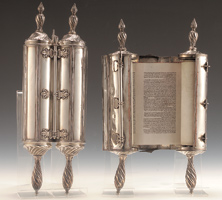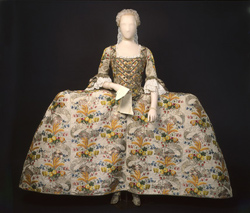The long-awaited refurbishment of two of London’s most prestigious museums, the Jewish Museum in Camden and the Museum of London at the Barbican, has put them top of visitors’ what-to-see list this spring.

The Jewish Museum in Camden Town, which is reopening (17 March) after transformation, looks at London through the eyes of the immigrant Jewish community. Visitors hear the Jablonsky family talk about East End life in the 19th century and see a tailor’s shop – the most popular occupation, how a table is set for Sabbath and even smell that delicious Jewish panacea of all ills, chicken soup!
As the first settlers came here in medieval times, it’s fitting that one of the museum’s prized new exhibits is a 13th-century Mikveh. This stone ritual bath was discovered during excavations in the City of London and is the first thing visitors see. Says Exhibition Project Manager Sarah Gillings, ”It’s beautifully carved and one of the few pieces of Judaica to have survived from that period. I’m also excited by one of only two 1920s surviving silk banners from the London Jewish Bakers’ Union and the beautiful neo-classical Torah travelling scrolls, made by an 18th-century London silversmith. There’s also the wonderful decorated Torah ark, found in a Northumberland castle where it was being used as a wardrobe!”
I liked the Yiddish theatre exhibit. Presented by comedien David Schieder, it has costumes, posters, programmes and even karaoke for the would-be performer!
No aspect of Jewish life, from initial settlement here to customs, trades and Judaism has been forgotten in this fascinating museum, which now stretches over two buildings in the heart of Camden Town.
The Museum of London hasn’t had
a face-lift since it moved to its present site in 1976. Now a major
investment sees viewing space enlarged by 25 per cent and more than
7,000 objects on view from the end of May. “We have five new galleries,
which means that we can display things that are in the collection but
rarely shown,” explains Director of Collections Cathy Ross. “Because of
lack of space, our 20th-century objects only went up to l914. Now the
items on permanent view include the Selfridges Art Deco lift, the
Firestone factory gates and Whitefriars 1960s art glass.”

More costume is displayed on 70
mannequins spread throughout the museum, many wearing exquisite 18th-century Spitalfields silk, woven by immigrant Huguenots, including the spectacular Fanshawe dress (a court dress thought to have been worn by Mrs Ann Fanshawe when her father, Crisp Gascoyne, was Lord Mayor of
London in 1752-53). Some ‘stroll’ in a clever reconstruction of the Vauxhall Pleasure Gardens and London-made goods like Chelsea porcelain, intricate watches and clocks are shown, too. There are glitzy Edwardian and 1920s dresses and also post-1950s designs from Biba, Mary Quant and Alexander McQueen. The tough side of London life hasn’t been forgotten, with displays on Charles Booth’s coloured ‘poverty maps’, destitution and disease in the East End, debtors’ prisons and suffragettes on hunger strike
The Museum of London has always been a bit tucked away inside the Barbican complex. One of the most exciting innovations for me are the new street-level windows along London Wall, where passersby are enticed inside by the sight of the Lord Mayor’s Coach. Cathy Ross’s favourite display is about Protein Man (Stanley Green). “He paraded along Oxford Street between 1968-1993 with a placard saying, “Less lust by less protein, meat, fish, bird, egg, cheese, peas, beans, nuts and sitting”!” A wonderful London eccentric.
Jewish Museum, Raymond Burton House, â¨129-131 Albert Street, â¨Camden Town, â¨London NW1 7NB; tel: (020) 7284 7384. Museum of Londonâ¨, London Wall, â¨London EC2Y 5HN; tel: (020) 7001 9844. Report by Pat Moore






 © 2024
© 2024